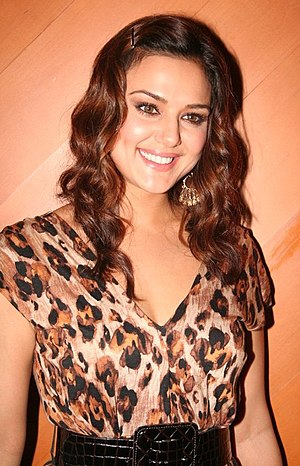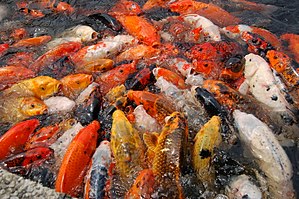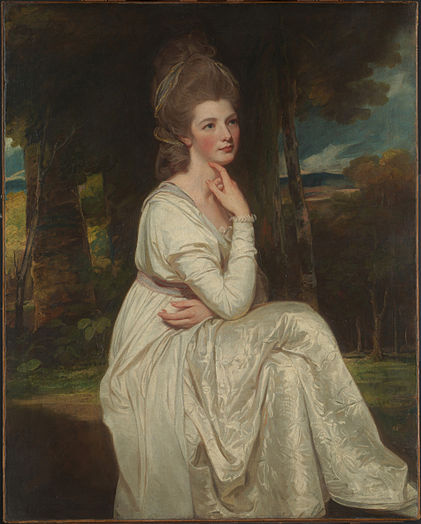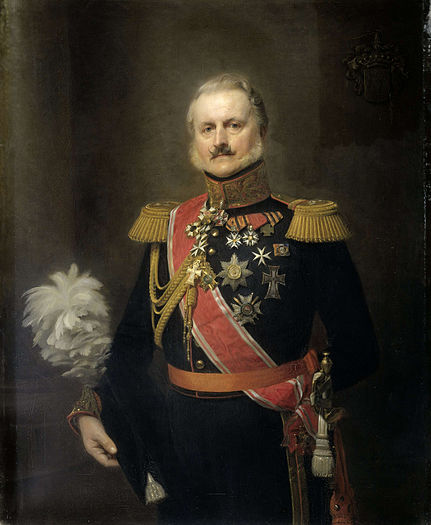Wikipedia:Wikipedia Signpost/2015-02-18/Featured content: Difference between revisions
Appearance
Content deleted Content added
h |
timeline, logic |
||
| Line 40: | Line 40: | ||
Seventeen [[WP:FP|featured picture]]s were promoted this week. |
Seventeen [[WP:FP|featured picture]]s were promoted this week. |
||
[[File:Hanna Pauli - Frukostdags.JPG|thumbnail|300px|Breakfast behind the |
[[File:Hanna Pauli - Frukostdags.JPG|thumbnail|300px|Breakfast behind the restaurant ..... ]] |
||
[[File:Zehnder's Chicken Restaurant, Frankenmuth, Michigan, 2015-01-11 01.jpg|thumb|300px|Zehnder's Chicken Restaurant]] |
[[File:Zehnder's Chicken Restaurant, Frankenmuth, Michigan, 2015-01-11 01.jpg|thumb|300px|Zehnder's Chicken Restaurant]] |
||
[[File:Koi feeding, National Arboretum.jpg|thumb|300px|Koi feeding, (on Zehnder's Chicken?) at the National Arboretum]] |
[[File:Koi feeding, National Arboretum.jpg|thumb|300px|Koi feeding, (on Zehnder's Chicken?) at the National Arboretum]] |
||
| Line 47: | Line 47: | ||
<!--Repeat as appropriate--> |
<!--Repeat as appropriate--> |
||
<!--These can vary a bit. Choose as appropriate, or create own per examples.--> |
<!--These can vary a bit. Choose as appropriate, or create own per examples.--> |
||
* '''[[:File:Zehnder's Chicken Restaurant, Frankenmuth, Michigan, 2015-01-11 01.jpg|Zehnder's]]''' <small>''(created by [[ ]], restored and [[ |nominated]] by [[User: | ]])''</small> |
* '''[[:File:Zehnder's Chicken Restaurant, Frankenmuth, Michigan, 2015-01-11 01.jpg|Zehnder's]]''' <small>''(created by [[ ]], restored and [[ |nominated]] by [[User: | ]])''</small>[[Zehnder's]] is a large restaurant in [[Frankenmuth]], [[Michigan]], originally built as the Exchange Hotel by Henry Reichle in 1856. In 1927, [[William Zehnder]], Sr. purchased the hotel remodeling the building, including redesigning the front of the building to look like [[Mount Vernon]]. In the 1980s, it was one of the ten largest restaurants in the United States, with a seating for 1,500 people Zehnder's serves almost a million people annually. Reichle ran the hotel for twenty years, after which it was sold and operated by several different people. [[John Zehnder]], the executive chef and food and beverage manager at Zehnder's, received the 2011 Hermann G. Rusch Chef's Achievement Award from the [[American Culinary Federation]]. |
||
* '''[[:File:Koi feeding, National Arboretum.jpg|Koi feeding]]''' <small>''(created by [[ ]], restored and [[ |nominated]] by [[User: | ]])''</small> Koi is a pet fish, held in ponds because they are belived to bring luck and money to the house. These guy are fighting for the food in a pond at the [[United States National Arboretum]]. The koi varieties are distinguished by coloration, patterning, and scalation. Some of the major colors are white, black, red, yellow, blue, and cream. Common carp were bred to a new breed, the koi, for color in [[Japan]] in the 1820s. By the 20th century, a number of color patterns had been established, most notably the red-and-white that is called ''Kohaku'' in Japanese. New koi varieties are still being actively developed. |
* '''[[:File:Koi feeding, National Arboretum.jpg|Koi feeding]]''' <small>''(created by [[ ]], restored and [[ |nominated]] by [[User: | ]])''</small> Koi is a pet fish, held in ponds because they are belived to bring luck and money to the house. These guy are fighting for the food in a pond at the [[United States National Arboretum]]. The koi varieties are distinguished by coloration, patterning, and scalation. Some of the major colors are white, black, red, yellow, blue, and cream. Common carp were bred to a new breed, the koi, for color in [[Japan]] in the 1820s. By the 20th century, a number of color patterns had been established, most notably the red-and-white that is called ''Kohaku'' in Japanese. New koi varieties are still being actively developed. |
||
Revision as of 15:37, 14 February 2015
 Article display preview: Article display preview: | This is a draft of a potential Signpost article, and should not be interpreted as a finished piece. Its content is subject to review by the editorial team and ultimately by JPxG, the editor in chief. Please do not link to this draft as it is unfinished and the URL will change upon publication. If you would like to contribute and are familiar with the requirements of a Signpost article, feel free to be bold in making improvements!
| ||||
Featured content
(A load of bull: Koi feeding, & a hungry moray eel, Spaghetti Nebula. )

Featured articles
Five featured articles were promoted this week.

- ARTICLE ([[ |nominated]] by [[User: | ]]) Description.
- James B. Weaver (1 Feb)
- I Never Liked You (nominated by Curly Turkey) I Never Liked You is an autobiographical graphic novel by Canadian cartoonist Chester Brown, originally serialized as Fuck in the pages of his comic book Yummy Fur. Brown was at the forefront of the 90s wave of autobiographical comics. Since cartoonists usually spent most of their days at the drawing table trying to eke out a living, here autobiography didn't mean high adventure, it meant the minutiae of human existence. These cartoonists put their own lives under the microscope, unflinchingly portraying their weird emotional states, sexual fantasies, and masturbatory habits. In I Never Liked You, Brown tells the story of his introverted teenage years in a Montreal suburb. He is painfully unable to express emotion, especially to women, including his dying mother and the girl next door he is interested in. The powerful story and minimalist style drew critical adulation and awards, so if you are in the mood to revisit your awkward adolescence, this is the book for you.
- Saint Francis Receiving the Stigmata (van Eyck) (5 Feb)
- The Thrill Book (5 Feb)
- William of Wrotham (nominated by Ealdgyth) William of Wrotham was a larger than life figure from the dramatic days of the English middle ages. When Robin Hood roamed Sherwood Forest, William was having action-packed adventures as... Archdeacon of Taunton and "keeper of ports". Like the Sheriff of Nottingham, William was a minion of King John, usually depicted as so villainous that the Magna Carta had to be forced upon him by his own rebellious barons. One of those rebels was William, who until that point had ably served John in a number of ecclesiastical and naval posts. After a brief time in exile, William was back in the good graces of John and his son and successor Henry III. Chronicler Roger of Wendover dubbed him one of John's "most wicked counsellors", but later historians called him a distinguished administrator.
Featured lists
Six featured lists were promoted this week.

- LIST ([[ |nominated]] by [[User: | ]]) Description
- Preity Zinta filmography (3 Feb) Preity Zinta is an Indian actress known for her work in Bollywood films. She made her debut in 1998 with a supporting role in the drama Dil Se.. and starred in the commercially successful thriller Soldier. In 2001, Zinta featured in the dramedy Dil Chahta Hai, which is cited in the media as a defining film of Hindi cinema. She starred in two blockbusters—the science fiction film Koi... Mil Gaya and the drama Kal Ho Naa Ho.....
- 67th Academy Awards (3 Feb)
- List of municipalities in Yukon (6 Feb)
- Vidya Balan filmography (6 Feb)
- List of World Series Cricket international centuries (6 Feb)
- Julia Roberts filmography (6 Feb)
Featured pictures
-
I like that, could be a new style bonett
-
Portrait of Doge Leonardo Loredan 600 hundred years later he is still waiting for his hat style to make a comeback
-
Not me, I like my feather duster
Seventeen featured pictures were promoted this week.





- Zehnder's (created by [[ ]], restored and [[ |nominated]] by [[User: | ]])Zehnder's is a large restaurant in Frankenmuth, Michigan, originally built as the Exchange Hotel by Henry Reichle in 1856. In 1927, William Zehnder, Sr. purchased the hotel remodeling the building, including redesigning the front of the building to look like Mount Vernon. In the 1980s, it was one of the ten largest restaurants in the United States, with a seating for 1,500 people Zehnder's serves almost a million people annually. Reichle ran the hotel for twenty years, after which it was sold and operated by several different people. John Zehnder, the executive chef and food and beverage manager at Zehnder's, received the 2011 Hermann G. Rusch Chef's Achievement Award from the American Culinary Federation.
- Koi feeding (created by [[ ]], restored and [[ |nominated]] by [[User: | ]]) Koi is a pet fish, held in ponds because they are belived to bring luck and money to the house. These guy are fighting for the food in a pond at the United States National Arboretum. The koi varieties are distinguished by coloration, patterning, and scalation. Some of the major colors are white, black, red, yellow, blue, and cream. Common carp were bred to a new breed, the koi, for color in Japan in the 1820s. By the 20th century, a number of color patterns had been established, most notably the red-and-white that is called Kohaku in Japanese. New koi varieties are still being actively developed.
- Antonie Frederik Jan Floris Jacob van Omphal (created by [[ ]], restored and [[ |nominated]] by [[User: | ]]) Antonie Frederik Jan Floris Jacob Baron van Omphal was a Dutch lieutenant-general and extraordinary aide-de-camp to William III of the Netherlands. He was awarded a knighthood in the Military William Order among other honors. Van Omphal excelled in the service of the French during the Battle of Leipzig (16–18 October 1813); at the time he was a first lieutenant for the second regiment of lancers of the Imperial Guard of Napoleon I. He also served in combat at Ciudad Real, and during the French invasion of Russia. Van Omphal was made a knight in the Military William Order, Grand Cross (1849) and commander (1857) in the Order of the Oak Crown, a knight of the Legion of Honour, a commander of the Guelph Order and the Order of the Dannebrog, a knight of the Order of St. John, of the Order of St. Anna second class with diamonds, of the Order of the Red Eagle second class, of the Order of the Sword with grand cross and of the Order of Saint Stanislaus first class, and a Grand Officer of the Order of Leopold (1859).
- Apse of Our Lady of the Assumption (created by [[ ]], restored and [[ |nominated]] by [[User: | ]])Our Lady of the Assumption in Windsor, Ontario. [[Our Lady of the Assumption, located at 350 Huron Church Road in Windsor, Ontario, is the oldest continuous parish in Ontario. On July 7, 1842 the cornerstone of the present church was laid. Three years later, on July 20, 1845 the new 60 x 120 ft. rectangular church was inaugurated under Fr. Pierre Point S.J. This rectangular structure forms the nave of the present parish. The church's high altar, spacious sanctuary, communion rail, and pipe organ make it an impressive and appropriate home for this historic liturgy, which attracts churchgoers from throughout southern Ontario and southeastern Michigan.
- Dancing Fairies (created by [[ ]], restored and [[ |nominated]] by [[User: | ]])Dancing Fairies (Swedish: Älvalek) is a painting by the Swedish painter August Malmström. The painting depicts fairies dancing above the water, in a moonlit landscape. August Malmström's Dancing Fairies is a widely recognised work in its home country. Malmström, who was a professor at the Royal Swedish Academy of Arts, was one of the Swedish artists who aspired to create a national Swedish art. The fairies dancing in the meadow in the twilight flow over the romantic landscape; one of them bends over the water to catch a glimpse of her own image. This visionary painting depicts the morning mist turning into fairies, like the spirits of untamed nature. Fairies were seen as delicate, tender, sensitive but also capricious and inclined to have their feelings hurt easily and take offence if not treated well.
- Tungabhadra River near Hampi (created by [[ ]], restored and [[ |nominated]] by [[User: | ]])Couple of coracles (round-shaped boats) at Tungabhadra river near Hampi, India. Coracles are used as mode of water transportation in this part of the world.
- Breakfast Time (created by [[ ]], restored and [[ |nominated]] by [[User: | ]]) Painting completed in 1887 by the Swedish artist Hanna Pauli (1864-1940). An open-air painting, Breakfast time depicts a tranquil scene with a table set for breakfast on a sunny morning. Placed at the bottom right of the picture is a table covered with a white tablecloth alongside a bench and two chairs. It is positioned under a tree with its branches stretching over the table. A maid is approaching the table carrying a tray in her hands. The light is reflected from the shiny objects on the table and from the white tablecloth. The painting of Breakfast time was completed by Hanna Pauli by the summer of 1887; later that year, in the autumn, she became engaged to her future husband, Georg Pauli, who was also an artist. When the painting was completed she was still unmarried, and the signature is her maiden name. Breakfast time was exhibited at the World Exhibition in Paris in 1889 and The Chicago World's Fair in 1893.
- Beech Grove I (created by [[ ]], restored and [[ |nominated]] by [[User: | ]]) This reproduction from the Google Art Project titled "Beech Grove I by Gustav Klimt" an Austrian symbolist painter and one of the most prominent members of the Vienna Secession movement. Klimt is noted for his paintings, murals, sketches, and other objets d'art. Klimt's primary subject was the female body. The most important element of his fame is his reputation as a master of eroticism. Characteristic of his style at the end of the 19th century is the inclusion of Nuda Veritas (nude truth) as a symbolic figure in some of his works, including Ancient Greece and Egypt, Pallas Athene and Nuda Veritas. It safe to say that he liked his ladies, naked.
- Drainage of water in Lake Urmia (created by [[ ]], restored and [[ |nominated]] by [[User: | ]]) An animation of the Lake Urmia drought (NASA images mixed using cross dissolve transition in adobe-premiere). Lake Urmia is an endorheic salt lake in northwestern Iran near Iran's border with Turkey. The recent drought has significantly decreased the annual amount of water the lake receives. This in turn has increased the salinity of the lake's water, lowering the lake viability as home to thousands of migratory birds including the large flamingo populations. The salinity has particularly increased in the half of the lake north of the causeway. The lake is between the provinces of East Azerbaijan and West Azerbaijan in Iran, and west of the southern portion of the Caspian Sea. At its full size, it was the largest lake in the Middle East and the sixth largest saltwater lake on earth with a surface area of approximately 5,200 km² (2,000 mile²), 140 km (87 mi) length, 55 km (34 mi) width, and 16 m (52 ft) depth. To infinity and beyond!
- Elizabeth Smith-Stanley, Countess of Derby (created by [[ ]], restored and [[ |nominated]] by [[User: | ]]) This painting of Lady Elizabeth Hamilton, by George Romney The Duchess of Hamilton, was considered one of the most beautiful women of the day. George Romney is a kinsman of American businessmen and politicians George W. Romney (1907–1995) and Mitt Romney; their ancestor Miles Romney was George Romney's first cousin.
- Echidna catenata (created by [[ ]], restored and [[ |nominated]] by [[User: | ]]) Chain moray eel below a feather duster worm - Echidna catenata, commonly known as the chain moray, is a moray eel found in shallow parts of the western Atlantic Ocean and from islands elsewhere in the Atlantic. It occasionally makes its way into the aquarium trade. The chain moray is found in the western Atlantic Ocean where its range extends from Bermuda, Florida and the Bahamas to the Antilles and Brazil. It is a carnivore and feeds on such organisms as crabs, which are the mainstay of its diet, shrimps, worms and small fish.
- Burking Poor Old Mrs Constitution, Aged 141 (created by [[ ]], restored and [[ |nominated]] by [[User: | ]]) A political cartoon based on the Burke and Hare murders, a series of murders committed in Edinburgh, Scotland, over a period of about ten months in 1828. The killings were attributed to Irish immigrants William Burke and William Hare, who sold the corpses of their 16 victims to Doctor Robert Knox as dissection material for his well-attended anatomy lectures. Before 1832, there were insufficient cadavers legitimately available for the study and teaching of anatomy in Britain's medical schools. As medical science began to flourish in the early nineteenth century, the demand for cadavers rose sharply, but at the same time the legal supply failed to keep pace. One of the main sources—the bodies of executed criminals—had begun to dry up owing to a reduction in the number of executions being carried out in the early nineteenth century.
The above is actually a political cartoon based on the Burke and Hare murders, so do work in the constitution and Catholics.
- Hayley Williams (created by [[ ]], restored and [[ |nominated]] by [[User: | ]]) Hayley Williams, lead vocalist of the American rock band Paramore, at Rock im Park 2013 in Nuremberg, Germany. Williams was discovered in 2003 by managers Dave Steunebrink and Richard Williams, who signed the 14-year-old to a two-year production deal. In the 2007 Kerrang! Readers' Poll she finished second to Evanescence's Amy Lee in the "Sexiest Female" category, going on to win the first place spot for "Sexiest Female" a year later in the 2008 poll, and again in the 2009, 2010, 2011 and 2012 poll
- Simeis 147 (created by [[ ]], restored and [[ |nominated]] by [[User: | ]]) Photograph by Rogelio Bernal Andreo of Simeis 147. Simeis 147, also known as the Spaghetti Nebula, SNR G180.0-01.7 or Sharpless 2-240, is a supernova remnant (SNR) in the Milky Way, straddling the border between the constellations Auriga and Taurus. Discovered in 1952 at the Crimean Astrophysical Observatory using a 25 inch Schmidt-Cassegrain telescope, it is difficult to observe due to its extremely low brightness. Also known as the Spaghetti Nebula and cataloged as Sharpless 2-240, this filamentary structure can be found in the constellation Taurus, close to the border of Aurigua, in roughly the same line of sight as the star Elnath. Approximately 3000 light years away, the nebula stretches about 150 light years across
- Feral Charolais bull (created by [[ ]], restored and [[ |nominated]] by [[User: | ]]) What a load of bull! Charolais cattle (French pronunciation: [ʃaʁɔlɛ]) are a beef breed of cattle (Bos taurus) which originated in Charolais, around Charolles, in France. They are raised for their meat and are known for their composite qualities when crossed with other breeds, most notably Angus and Hereford cattle. The breed tends to be large muscled, with bulls weighing up to 1,100 kilograms (2,400 lb) and cows up to 900 kilograms (2,000 lb). In England, a bull of this breed has reached the weight of 2 tons. The breed was introduced in the southern US from Mexico in 1934. In Sierra Nevada de Mérida, Venezuela, following the rural flight of farmers, many Charolais cattle were abandoned; they have survived in the wild feeding on Espeletia schultzii, a high altitude shrub.
- Dome ceiling of the Sheikh Lotfollah Mosque (created by [[ ]], restored and [[ |nominated]] by [[User: | ]]) Sheikh Lotfollah Mosque (Persian: مسجد شیخ لطف الله Masjed-e Sheikh Lotf-ollāh) is one of the architectural masterpieces of Safavid Iranian architecture, standing on the eastern side of Naghsh-i Jahan Square, Isfahan, Iran. The Dome ceiling of the Sheikh Lotfollah Mosque as described by Robert Byron, who wrote about this sight: I know of no finer example of the Persian Islamic genius than the interior of the dome: The dome is inset with a network of lemon-shaped compartments, which decrease in size as they ascend towards the formalized peacock at the apex... The mihrāb in the west wall is enameled with tiny flowers on a deep blue meadow. Each part of the design, each plane, each repetition, each separate branch or blossom has its own somber beauty. But the beauty of the whole comes as you move. Again, the highlights are broken by the play of glazed and unglazed surfaces; so that with every step they rearrange themselves in countless shining patterns... I have never encountered splendor of this kind before.
- Portrait of Doge Leonardo Loredan (created by [[ ]], restored and [[ |nominated]] by [[User: | ]]) Leonardo Loredan was the Doge of Venice from 1501–21. In Bellini's painting he is shown wearing his robes of state. The hat and ornate buttons are part of his official wardrobe. The sitter can be identified as Doge Loredan by comparing his features with portrait medals of him. The shape of the hat comes from the hood of a doublet. It is called a corno ducale and was a type of ducal hat, worn over a linen cap. The Portrait of Doge Leonardo Loredan is a painting by the Italian Renaissance master Giovanni Bellini, dating from 1501. It is on display in the National Gallery in London. It portrays Leonardo Loredan, Doge of Venice from 1501 to 1521, in his ceremonial garments with the corno worn over a linen cap, and is signed "IOANNES BELLINVS" on a cartellino.








Discuss this story